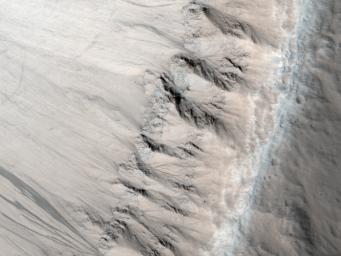
|
First Observation of Columnar Jointing on Mars
- Click the image above for a larger view
- Full-Res JPEG (2560 x 1920) (563.0 kB)
- Full-Res TIFF (2560 x 1920) (14.8 MB)
Caption:
This image from the High Resolution Imaging Science Experiment (HiRISE) on NASA's Mars Reconnaissance Orbiter shows an exposure of layered rock that exhibits a type of fracturing—called columnar jointing—that results when cooling lava contracts.
The observation is cited in a report, " Discovery of Columnar Jointing on Mars ," in the February 2009 issue of the journal Geology. The authors propose that flooding by water was likely what caused a quick cooling of lava to result in this jointing.
The image, taken Oct. 31, 2007, shows a portion of an unnamed crater 16 kilometers (10 miles) in diameter and centered at 21.52 degrees north latitude, 184.35 degrees north longitude. Shown here is a section about one kilometer (0.6 mile) wide from the image catalogued by the HiRISE team as PSP_005917_2020 . The column-forming fractures resemble textures common on Earth in locations such as the Colombia River Basalt Group and in the Colorado Plateau.
Background Info:
NASA's Jet Propulsion Laboratory, a division of the California Institute of Technology in Pasadena, manages the Mars Reconnaissance Orbiter for NASA's Science Mission Directorate, Washington. Lockheed Martin Space Systems, Denver, is the prime contractor for the project and built the spacecraft. The High Resolution Imaging Science Experiment is operated by the University of Arizona, Tucson, and the instrument was built by Ball Aerospace & Technologies Corp., Boulder, Colo.
Cataloging Keywords:
| Name | Value | Additional Values |
|---|---|---|
| Target | Mars | |
| System | ||
| Target Type | Planet | |
| Mission | Mars Reconnaissance Orbiter (MRO) | |
| Instrument Host | Mars Reconnaissance Orbiter | |
| Host Type | Orbiter | |
| Instrument | High Resolution Imaging Science Experiment (HiRISE) | |
| Detector | ||
| Extra Keywords | Color, Crater, Water | |
| Acquisition Date | ||
| Release Date | 2009-02-25 | |
| Date in Caption | 2007-10-31 | |
| Image Credit | NASA/JPL-Caltech/University of Arizona | |
| Source | photojournal.jpl.nasa.gov/catalog/PIA11809 | |
| Identifier | PIA11809 | |
